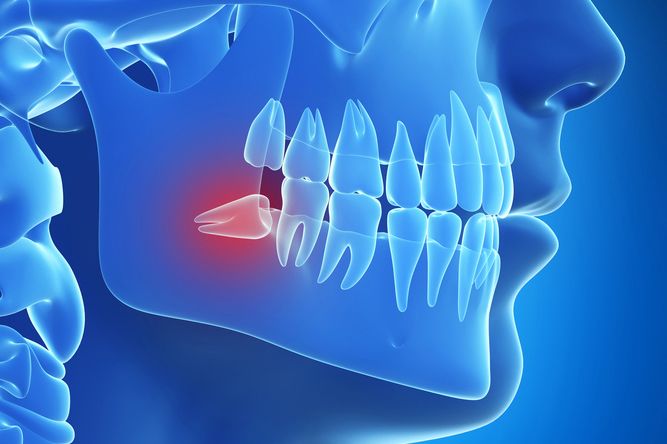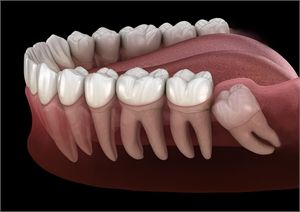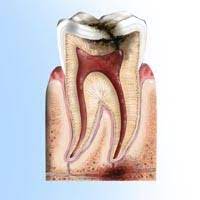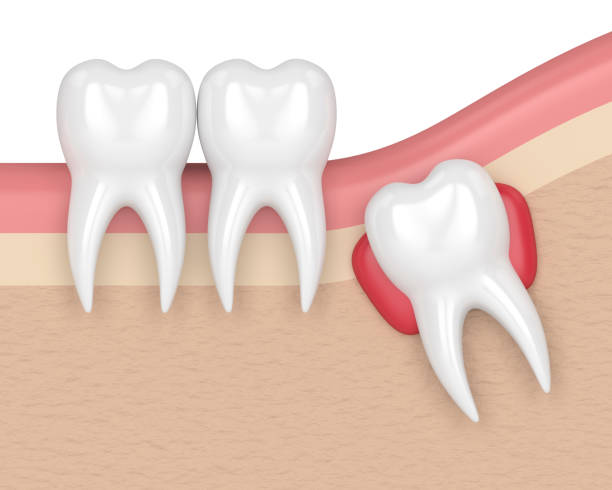
Removing a tooth is necessary when decay or an abscessed tooth is so severe that no other treatment will cure the infection.
Removing a tooth can help keep infection from spreading to other areas of your mouth and or head and neck.




Wisdom teeth, also called 'third molars' usually do not push through the gums until people are in their late teens, twenties or even older. They are usually the last teeth to come through the gums.
Most people have four wisdom teeth. Some people may have less, or not at all. Often there is little space at the back of the jaws for the wisdom teeth to come through. If the jaw does not have enough room to accommodate the wisdom tooth, the tooth will become wedged in or 'impacted'. Some impacted wisdom teeth remain buried and cause no trouble. However, other impacted wisdom teeth may cause severe problems.
Often one or more wisdom teeth will cause problems and must be removed. It is a very common procedure and should usually be done as soon as possible before the problems get worse.
When an impacted wisdom tooth starts to push through the gum, an infection can start around the top of the tooth. Infection and inflammation can cause pain, swelling, and jaw stiffness. Swallowing may be painful and the person may feel generally unwell. The infection can cause bad breath and an unpleasant taste.
Pressure from the wisdom tooth may cause pain in the tooth next to it. Pain can also be caused by the infection around the wisdom tooth.
A wisdom tooth may push nearby teeth out of their correct position and may help cause crowding of front teeth.




If a wisdom tooth is not removed, a sac of fluid, called a cyst can form around the tooth and may displace the tooth. The cyst can destroy bone tissue and damage other teeth and the gums. Cyst formation around unerupted teeth is uncommon.
An impacted wisdom tooth may keep pushing against the molar next to it. This can cause an 'erosion cavity' where the wisdom tooth hits the other molar. This often leads to serious damage to both teeth. The molars may become infected or abscessed. Removal of both molars is often needed.
An upper wisdom tooth may push sideways out of the gum. It may cause an ulcer where it rubs against the inside of the cheek.
Food becomes trapped between the wisdom tooth and the molar next to it. This can cause decay in both teeth.
A jaw x ray called an OPG is needed to scan the whole mouth to examine the position and development of the wisdom teeth. This will also help to plan the best way to remove the wisdom teeth and possibly other problems.
You have choice of having the wisdom teeth removed in the chair with Local Anaesthetic or in a hospital under General Anaesthetic. This usually depends on the number and difficulty of the wisdom teeth removal as well as the patient's wish. If you have a particular preference, please inform us.
An incision is often required to open the gums to remove the wisdom tooth. A small portion of the bone may have to be removed to provide access to the tooth. The tooth may have to be divided into segments so it can be removed safely and easily. The incision in the gums may have to be closed with stitches that are either dissolvable or will be removed at the review appointment. You will be given a set of instructions to follow after the procedure.
All types of surgery have risks. Removal of wisdom teeth also has risks. Complications do not happen often but may occur. The following list of possible side effects is intended to inform you about some of the potential problems. As other uncommon complications may occur, the list is not complete. If you have any concerns about possible risks or complications, please do not hesitate to ask for more information.
 Numbness or altered sensation - An impacted wisdom tooth may be close to nerves within the jaw bone and surrounding tissues. When the tooth is removed, the nerve may become bruised. This can cause numbness, tingling and loss of feeling in teeth, gums, cheeks, lips, chin, tongue and around the upper jaw and lower jaw. Taste sensation may be altered as well. If a nerve is injured, it usually will heal and the symptoms go away. In some people the healing process can take 6 to 18 months. In rare cases, the nerve may not heal completely and the symptoms may be permanent.
Numbness or altered sensation - An impacted wisdom tooth may be close to nerves within the jaw bone and surrounding tissues. When the tooth is removed, the nerve may become bruised. This can cause numbness, tingling and loss of feeling in teeth, gums, cheeks, lips, chin, tongue and around the upper jaw and lower jaw. Taste sensation may be altered as well. If a nerve is injured, it usually will heal and the symptoms go away. In some people the healing process can take 6 to 18 months. In rare cases, the nerve may not heal completely and the symptoms may be permanent.
 Dry socket - After the tooth is removed, a blood clot will form over the bone. This is important for proper healing and relief of pain. If the blood clot is washed away or dislodged, the bone will be exposed. This is called a 'dry socket'. The result is a constant throbbing pain which may last for many days. Further treatment is required.
Dry socket - After the tooth is removed, a blood clot will form over the bone. This is important for proper healing and relief of pain. If the blood clot is washed away or dislodged, the bone will be exposed. This is called a 'dry socket'. The result is a constant throbbing pain which may last for many days. Further treatment is required.
 Infection - An infection in the gum or bone is uncommon and can be treated with antibiotics
Infection - An infection in the gum or bone is uncommon and can be treated with antibiotics
 Difficulty in opening the mouth - This is often due to the swelling of the gum and usually goes away in a few days after the swelling goes down
Difficulty in opening the mouth - This is often due to the swelling of the gum and usually goes away in a few days after the swelling goes down
 Fever - Your body temperature may be slightly higher after surgery. It usually goes back to normal after 12 to 24 hours. A fever which lasts longer may be an indication of an infection or other problems. Contact the surgery.
Fever - Your body temperature may be slightly higher after surgery. It usually goes back to normal after 12 to 24 hours. A fever which lasts longer may be an indication of an infection or other problems. Contact the surgery.
 Excessive bleeding - This is rare and can be caused by too much exertion or by vomiting. It can be stopped by putting gauze over the site and applying pressure by biting gently on the gauze for 20 to 30 minutes. If severe bleeding does not stop, contact the surgery or hospital emergency department.
Excessive bleeding - This is rare and can be caused by too much exertion or by vomiting. It can be stopped by putting gauze over the site and applying pressure by biting gently on the gauze for 20 to 30 minutes. If severe bleeding does not stop, contact the surgery or hospital emergency department.
 Lip sores - While the tooth is being removed, pressure or stretching of the lip by the instruments may cause bruises or small sores
Lip sores - While the tooth is being removed, pressure or stretching of the lip by the instruments may cause bruises or small sores
Wisdom teeth often cause pain, infection, or misalignment when they don’t erupt properly. Kakatiya Superspeciality Dental Hospital offers safe and painless wisdom tooth extraction.
The procedure is done under local anesthesia, so it is painless. Mild swelling or discomfort afterward can be managed with medication.
Most patients recover within 3–7 days. Our oral surgeons provide complete aftercare for faster healing.
The price depends on whether the tooth is impacted or simple extraction. Kakatiya Superspeciality Dental Hospital offers affordable wisdom tooth extraction services.
Yes, multiple wisdom teeth can be removed in one sitting if necessary. Our dental surgeons ensure safety and comfort throughout.